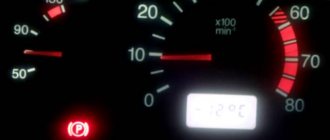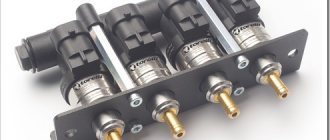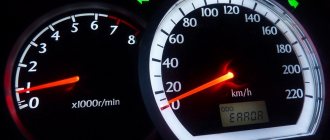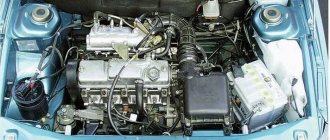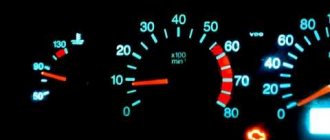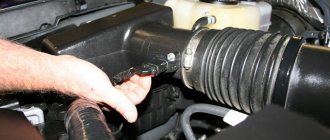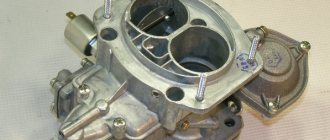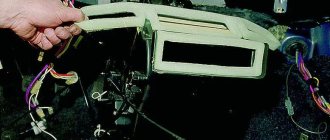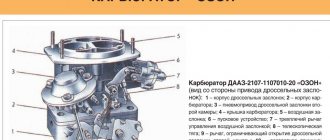Often, a malfunction of the power unit at idle is associated with the failure of one or more sensors at the same time. This includes the mass air flow sensor, crankshaft position sensor, and idle air control.
Before starting any work, check the spark plugs and air filters. For this reason, they may run out of resources and their income will begin to fluctuate. Also check the high voltage cables, are they intact or is there any damage?
Checking the idle air control
To diagnose this device, you will need a multimeter. With its help we check the resistance of the contacts. Set the operating mode of the multimeter in the “ohmmeter”. Then we perform the following simple steps:
- Turn off the engine and completely de-energize the car
- Disconnect the connection block
- We measure the resistance of the IAC contacts
- Comparing the measurement results with normal values
If the resistance value deviates from normal values, the regulator must be replaced with a new one. After all, it is the governor that causes the RPM fluctuations in most cases. To disassemble a failed mechanism, simply disconnect the battery terminals and loosen the regulator fastenings. Place the working device in its place.
Problems and solutions
There are a lot of reasons for unstable idle, and they apply to both carburetor and injection engines and even diesel engines, both to the old type design and to the new E-gas pedal, which AvtoVAZ is so proud of. Let's start with the problems that occur in carburetor-type engines:
- The fuel-air mixture has become lean. To fix the problem, you just need to make an adjustment to the level of eight hundred revolutions.
- Unstable running can also occur due to wear on the carburetor valve. In this case, the engine operates exclusively with the choke mode extended. To fix the problem, you need to replace the defective part with a new one.
- It also happens that the system channels become dirty. Then the fuel does not receive the required portion of air and leads to failure. Here you just need to clean the channels.
Idling.
ADJUSTMENT IN PRACTICE + THEORY. In the injection type of engine, there are no fewer reasons for failure.
- The first thing you can check is air leaks. Be sure to check the connection between the intake manifold and the cylinders to see if the gaskets are worn out. There are rubber plugs on the same manifold; if they are cracked, it is better to replace them. You can check all this by buying carburetor cleaner or any other flammable item in the store, start the car and spray all the joints, if there is a leak, the car will start to twitch, look in that place.
- They can cause gaps in speed and malfunctions in the IAC sensor (idle air control), it is often enough to remove it and clean it or inspect it for damage and replace it if necessary.
- It would not be amiss to check the throttle assembly, since it is not the strong point of the fourteenth model. It is possible that the throttle valve is simply clogged, which causes failures in the entire system. Cleaning it is not at all difficult; this work can be done independently.
- Wear or contamination of spark plugs also affects idle speed, as well as the entire operation of the engine. This is perhaps the most quickly solvable problem that can be eliminated by replacing old spark plugs with new ones in five minutes.
But problems with electronic equipment, in particular the famous E-gas, are much more complicated. Here it is observed:
- regulator failure (IAC);
- DMRV sensor failure;
- failure of the EGR valve (adsorber);
- damage to wires.
The regulator is checked using a multimeter. If the device produces unacceptable values, above 80 Ohms, then you need to replace the regulator with a new one, since repairing it will be problematic.
If the regulator is normal, then you need to check the mass air flow sensor. The check is as follows: the connector is disconnected and the motor is turned on.
If the speed dynamics, at the initial one and a half thousand revolutions, increases, there is no doubt that the breakdown lies in the sensor. As practice shows, 80% of VAZ-2114 malfunctions lie in this part.
Unstable to long-term operation and EGR, which regulates exhaust gas emissions. When it fails, operation can be normalized by cleaning the valve.
And the last thing that should be checked is the condition of the air filters, which on the fourteenth get clogged quite often, and the ignition system itself.
So, we found out the reasons for the occurrence of unstable idle speed of the fourteenth VAZ model and learned methods for eliminating them. All that remains is to wish that your swallow works without failures and pleases you with excellent work!
The main reasons for high speed
As a rule, high speeds of the VAZ 2114 are caused by one of the following breakdowns:
- gas sensor (throttle position) has failed);
- The air flow sensor is faulty.
- idle speed sensor is broken;
- the air filter is clogged;
In addition to the above reasons, increased RPM can be caused by simpler things, such as a flying throttle cable. Such problems can be identified and eliminated during the initial inspection, so we will not dwell on them and talk about checking and replacing sensors.
OPTIONS FOR TROUBLESHOOTING
It is clear that if any emergency situations arise with the motor, it is advisable to contact a specialized service. However, this procedure is not always possible. Therefore, it is worth knowing how to independently diagnose the main systems and key parts.
THROTTLE VALVE AND ASSEMBLY
When the speed drops at idle and the car stalls, you need to pay close attention to the details of the throttle assembly. Long-term operation of the car on low-quality fuel, untimely maintenance of the air filter can lead to malfunctions of the throttle valve
It periodically jams if debris gets into the equipment.
Throttle valve VAZ 2112
The problem can be solved by cleaning the system. The throttle is cleaned using carburetor cleaners. Using a compressor, you need to blow out the damper under the pressure of compressed air. It is not recommended to touch the screws located inside and on the side. If cleaning does not correct the situation, the device must be replaced. This operation is not particularly difficult.
CRANKCASE FAILURE
There is an oil trap in the crankcase ventilation system of the engine. Its contamination can also lead to interruptions in engine operation. Crankcase gases do not allow the engine to function normally, the speed fluctuates, the internal combustion engine stalls.
SENSORS
If a gasoline car stalls at idle, then one of the sensors is likely to break. In injection cars with an electronic engine control system, the engine usually starts normally, but then it stops working. It's worth checking here:
- Electronic car indicators;
- DRХХ – device that regulates idle speed;
- Air flow meter (air intake in the carburetor);
- Sensor indicating the position of the throttle curtain.
Electronic control unit in VAZ 2114
Interruptions in the operation of any sensors immediately affect the behavior of the electronics - errors appear in the car control unit. The “brains” of the machine receive unreliable information. It is not transmitted correctly to the engine. It starts working with parameters that do not correspond to reality. Self-testing of this device is not possible. You need to contact a professional for service.
Diagnostics of mass air flow sensor
About the idle speed sensor VAZ 21099 (2109)
The idle air control device is usually to blame for engine malfunction when the car idles poorly. But you pressed the gas pedal and the engine started. In the latest VAZ modifications, error information appears on the instrument panel.
When diagnosing, you must use a multimeter. If a part is faulty, it is recommended to replace it with a new one. All sensors are reasonably priced. It is better to start checking with parts that have a simpler design. Then gradually move on to complex devices. We must not forget that the problem may lie not only in the sensors themselves. It is also necessary to check the wiring to them and the presence of stable contact.
CARBURETOR
If the VAZ carburetor stalls at idle speed, then the jets may become clogged. Low-quality gasoline, deposits from the gas tank, contain small particles of debris. They can easily disrupt the operation of the fuel injection system. It is worth replacing the filter in front of the carburetor and cleaning the device itself. The dispensing part is cleaned using a cleaning solvent, which is sold in aerosol cans. Another reason is often a prolonged lack of carburetor adjustment.
In a mechanical fuel pump of carburetor cars, the filter mesh may be clogged with dirt. This reduces the performance of the device. Wear of the membrane and its destruction often leads to clogged carburetor channels.
INJECTOR
A situation that often arises is that various Lada models, as well as the VAZ 2110 injector stalls at idle. It is necessary to check the fuel pump strainer for clogging. This is a common problem with injection machines. It is better to immediately replace the part with a working one.
FILTERS PROBLEM
If the VAZ 2112 stalls at idle, then the fuel filter may be dirty. This also applies to other models of the concern. Generally, it is not practical to clean it. The part must be replaced. The same should be done with a dirty air filter. Low throughput leads to the fact that the air-fuel mixture simply floods the spark plugs.
Self-checking will not always lead to a positive result. It is often more practical to identify the cause of unstable operation of the internal combustion engine at a car service center. It will cost more, but specialized diagnostics will prevent more serious damage to the car.
Diagnostics of the mass air flow sensor
To test this sensor, you will also need a multimeter, but it should already be set to "voltmeter" mode. We run the MAF diagnostics as follows:
- De-energize the car by removing the battery terminals
- The normal value is a voltage between 0.99 and 1.02 V
- We measure the voltage between the contacts of the green and yellow wires
In some cases, it helps to simply clean the sensor or remove its oxidized contacts. But such actions do not always lead to the desired result. It is best to replace the mass air flow sensor with a new one and forget about the problem, especially since this is an inexpensive mechanism.
Why does the idle speed fluctuate on carburetor engines?
The VAZ-2114 Samara with a carburetor internal combustion engine is also not immune to this problem. This happens, fortunately, not every day, but still. The main reason for this is an incorrectly adjusted or faulty carburetor itself. Also, floating speed can be caused by air leaks or a faulty XX solenoid valve. In addition, it is worth checking the air filter for deposits.
But most often, floating speeds arise precisely because of incorrect carburetor adjustment. In this case, you should adjust it by correctly rotating the fuel quality and quantity screws.
As for the solenoid valve, it can be diagnosed without removing the power wire from it. With the ignition on, it is enough to touch the contact on the valve with the cord - a characteristic click should soon appear. If it is not there, you can try to touch the contact with the wire that is connected to the positive terminal on the battery. If after this you do not hear a click, then most likely the valve has malfunctioned. To repair it, you need to unscrew it and clean the nozzle.
So, we found out why the speed on the VAZ-2114 fluctuates and how to fix this problem depending on the type of fault.
Hello everyone, I want to share with you a problem: idle speed on the VAZ 2124.
My revolutions dropped, after the car warmed up, after re-gassing the revolutions dropped to 500 and returned to 1000. Many said that the idle speed sensor needs to be changed. I read on the forums that there are fakes everywhere, I didn’t bother and immediately went and bought myself an idle speed sensor.
If you look closely, there is a working out, the needle moves left and right, it spins. In my opinion, I paid 250 rubles for this sensor, as I later found out, the workmanship is very poor quality, there are gaps all around.
After that, I found the original sensor and paid 800 rubles for it. I changed the sensor, removed the throttle completely, disassembled and cleaned it. The only problem was that my breather was clogged and I cleaned it.
I thought that I would put it on now and start it. But it was not there. I went for diagnostics and they said that the sensor was lying. I came to a friend and together we installed a new sensor. It works perfectly, no errors, shows the norm.
VAZ 2113-15 floats idle
The main problem turned out to be the absorber. It is designed to allow gasoline vapors that collect in the tank to be sucked through the absorber and through a hose to throw the vapors behind the manifold space. There is a tube coming from the damper. They stand without a filter.
After I removed the hose, the car started working differently. The turnover situation has disappeared.
I hope I helped you, bye everyone!
The “fourteenth” model from the domestic automaker AvtoVAZ gained enormous popularity in its time due to its reliability, workmanship, responsiveness and agility of the power unit.
Of course, this car cannot be called ideal. Therefore, problems may arise from time to time. It is not uncommon for the rpm to fluctuate at idle. Such phenomena irritate the driver and lead to unpleasant scenarios on the road. For example, at any moment the engine may simply stall.
It is unlikely that you will be able to solve the problem for a long time by pressing the accelerator pedal in order to maintain speed. Therefore, more drastic actions need to be taken.
VAZ 2114 - idle problem!!!(1)
Why does the speed fluctuate on the VAZ-2115 injector?
Often, owners of a VAZ-2115 with an injection engine are faced with a situation where the idle speed begins to fluctuate. At first glance, this malfunction is insignificant. However, first of all, this simply irritates the driver; moreover, a car parked at an intersection in “neutral” can simply crash and thereby provoke an emergency situation. Also, do not forget about the increase in fuel consumption. In fact, in order not to stall, you need to constantly “play” with the accelerator, maintaining the speed at the desired level. So it is best to take this problem seriously.
How to adjust the idle speed on the injector yourself?
Many car owners remember the time when mainly Zhiguli and Muscovites drove along the country's roads. Their key characteristic was that it was very easy to carry out minor repairs or adjust certain parameters, only armed with a small set of tools. However, the difference between those cars and their modern counterparts was that they had a carburetor fuel supply system. She didn't use electronics, so everything was regulated mechanically.
What is high engine speed
The rotation of the motor depends on the amount of air supplied. The air mixture enters through the throttle valve, then passes through the intake manifold to the cylinder block. The throttle position sensor (TPS) transmits the opening angle data to the ECU. The computer calculates the amount of entrained air and determines the amount of fuel that must be supplied to create the working mixture. As a result, high rpm occurs due to incorrect ECU calculations or excessive air entering the engine.
During normal engine operation during startup and at idle speed, for example at idle, the rotation speed is low: up to 600 - 1000 per minute. The readings are displayed on the speedometer. The engine can be rotated at high speeds, 1100 – 2500 rpm, “in the cold” in winter in 10 seconds. During this time, the engine heats the oil and coolant to an operating temperature of + 80 ℃… + 90 ℃. The engine will become louder.
If the tachometer needle does not drop for a long time, you need to look for the cause of the high speed.
High revs when starting the engine or “hot” can be constant or fluctuating. “Swimming” is typical for injection engines. If there is a lot of air in the combustion chambers, the injector will supply a lot of fuel, as shown by the computer. Turnover will increase. But gradually the mixture will become leaner, and the engine will begin to stall. The pressure gauge can drop to 500 rpm, but with a new portion of the air mixture the process will be repeated, and the number of revolutions will become higher.
https://youtu.be/nfg_O5KOhsk
Similar item Do-it-yourself engine repair 402 ZMZ
Idle speed sensor. Operating principle, signs of malfunction.
The idle speed sensor (dhx), or more correctly called the “idle speed regulator” (irx) on the VAZ 2114 and on other Samara families is designed to stabilize and automatically adjust the idle speed. The idle speed sensor is an electric motor with a tapered needle.
Where is the idle air control (IAC) located?
The idle speed sensor is located on the throttle body. The idle speed sensor is located next to the throttle position sensor. The DXX is secured with two screws. It also happens that the sensor is mounted on the varnish.
Photo of idle speed sensor (рхх)
The idle speed sensor is located at number 3. Next to number 4
Operating principle of the idle speed sensor (IAC)
The moment we turn on the ignition, the rod on the idle speed control fully extends and rests against a special calibration hole in the throttle pipe. Afterwards, the sensor counts the steps and returns the valve to its original position. The position of the initial valve depends on the firmware: for example, January 5.1 - 120 steps on a warm engine, Bosch - approximately 50 steps on a warm engine.
On a warm engine at the time of adjustment, the sensor is at around 30-50 steps. As the steps increase or decrease, the volume of air passing through the calibration hole constantly changes. Moreover, if the rod is extended, then the steps increase and vice versa. The stroke of the rod is 250 steps.
At the time of purchasing an idle speed sensor for a VAZ, the distance from the rod head to the flange should be no more than 23mm. Carefully measure the length of the protruding head.
The engine receives a certain amount of air necessary for normal engine operation, thereby regulating the idle speed.
The incoming air is analyzed by the mass air flow sensor (MAF) and, in accordance with its quantity, the Controller supplies the required amount of gasoline to the engine through the fuel injectors. Using the crankshaft position sensor (CPS), the controller monitors the number of engine revolutions and controls the idle speed control. This is how the process of supplying the required volume of air occurs.
VAZ 2114 has low idle speed
What needs to be done to get such an important car part working?
- The first thing to do is turn off the battery. Some drivers believe that it is enough to turn off the ignition, but in reality this is not the case. It is necessary to turn off the so-called “mass”.
- Once this is done, you need to unscrew the fastening elements holding the regulator. Likewise, you can remove it completely. This will not be difficult if you do everything carefully and slowly. Some models have an unpleasant feature. The fact is that their screws are filled with special paint. Sometimes they are completely perforated. In this case, it will be necessary to completely disassemble the shock absorber housing. Once this is done, you can disassemble the regulator and remove it.
Idle speed control
- It's time to clean the landing channel. You can simply rinse it and then blast it with a powerful blast of air. A gas can or a simple compressor is suitable for this. Disassemble the regulator very carefully, otherwise unpleasant consequences may occur. For example, the winding can be easily damaged. Next you need to check the bushing. If something is wrong, it is better to replace it with a new one.
- The next step is to determine the integrity of the spring. To do this, you can use a special measuring device. It would be a good idea to clean the winding contacts. Only after this can you begin to install the idle air control, but first you need to measure the distance from the conical needle to the flange. It should be 23 mm. If the distance is different, the needle needs to be replaced.
- The last step is to install the regulator back to where it was before it was removed from the vehicle. He has a headquarters. It must be returned there. This must be done as carefully as possible. Once the regulator is in place, you need to connect the plug to it. You can do it yourself.
It's time to turn on the power. The engine must be running. If the problem cannot be solved, you will have to disassemble the regulator a second time. If the next attempt is unsuccessful, the driver should be advised to reflash the on-board computer.
This may be relevant for those who bought a car on the secondary market, but reflashing is a last resort. Usually, all car owners simply need to disassemble the regulator and repair it.
The revolutions are floating. Cleaning IAC - Lada 2115
With the onset of autumn, a problem began to bother me - the idle speed began to fluctuate. In principle, this happened in the fall before, but somehow just a little. And now it has become so bad that the car began to stall while driving. And sometimes you start it several times, and it immediately stalls.
Moreover, this also happens to a friend on a gelding. This really infuriated me. What’s interesting is that you drive around and the problem goes away, and sometimes it doesn’t appear at all. I came to the conclusion that the idle speed control was acting up. After reading the Internet, I realized that the problem can be solved not only by replacing the regulator, but also by flushing the regulator with a bucket.
In fact, it turned out to be not so easy to remove. One of the two screws prevents the removal of the plastic receiver. The book says that in order to remove the IAC, you need to remove the entire throttle assembly, and this is about an hour of work. I got out of it in a more cunning way - by unscrewing the throttle valve and squeezing it to remove the screw.
First you need to remove the throttle cable from the damper. Having removed the bracket, pull it back and remove the cable.
Now you need to unscrew the 2 nuts securing the throttle to the receiver. He unscrewed it, then wrung it out, and inserted a stick to hold it in place. Now we can get to the screw, unscrew the screws.
I got it out and this is the condition it is in.
I don’t know how serious the contamination is, but I washed it with a bucket, and this is what it looked like.
I put it in place. I screwed everything back. I start it up and everything works fine, stable. And what’s interesting is that now when you release the gas, the speed does not drop as before, but remains for about a second. Those. Acceleration has now become much easier.
At first everything worked fine, then the speed started to fluctuate a little again. And now they have started to periodically take out my brain again. Yesterday it completely stalled while driving, right when I needed to get onto the road. As a result, it stalled twice, blocking traffic in both directions. This is all so much fun. In short, I don’t know what to do, I’ll probably have to buy a new idle air regulator. Let's hope this helps.
Source
Repair rules
The idle speed regulator is a special actuator required for the engine to operate in normal mode. If it turns out to be defective, the indicator will not light up, indicating this defect. This means that identifying the problem can be quite simple. All that remains is to eliminate it as soon as possible.
The regulator is a stepper motor that allows you to guarantee a certain level of air flow bypassing the closed damper.
The range is set by the vehicle's electronics. Such a complex system allows the engine to operate as smoothly and stably as possible. In addition, the electronic system of the machine serves as protection against external factors, since the engine operates normally in almost any conditions.
Principle of operation
Turning on the ignition, the on-board computer begins to test the system. You can hear the fuel pump starting and all the lights on the instrument panel light up. At the same time, the idle air control completely blocks the air flow, and the control unit calculates the required number of steps and removes the needle, slightly opening the channel to the desired position.
The distance to the air flow can be different and depends on the parameter: hot or cold motor. For example, for warming up a rich mixture is required, which means the needle is extended as much as possible, but for operation on a hot engine the mixture is lean, that is, the regulator removes the lead screw, increasing the air supply.
Troubleshooting
To more accurately determine the problem, it is recommended to first carry out a full diagnosis. If you don't have the time or money to take your car to a gas station, we recommend using a personal ODBII scanner. In our case, this will be the Korean-made Scan Tool Pro Black Edition model
.
This scanner operates on a 32-bit chip (analogues in the budget segment have an 8-bit controller) and is assembled only from high-quality components, thanks to which it is capable of diagnosing not only the engine, but also other components of the car.
In most cases, the root cause of overspeeding is a dirty air filter, faulty throttle position sensor, idle speed sensor or mass air flow sensor. In addition to detecting errors for more detailed diagnostics, Scan Tool Pro can monitor the status of all available sensors in real time, helping you quickly determine the exact cause of the problem.
Air filter
The first thing you need to check, noticing the high idle speed of the VAZ 2114, is the air filter. When it becomes dirty, it begins to pass air poorly, as a result of which the working mixture entering the engine becomes excessively rich and causes an increase in speed. To fix this problem, just replace the filter with a new one.
Air filter VAZ 2114
Since the performance of the engine directly depends on the condition of the air filter, it is advisable to periodically check its condition without waiting for severe clogging.
Throttle position sensor
If this does not help, you should move on to checking the sensors, that is, the throttle position sensor, since most of the time it fails. To do this, it is necessary to measure the voltage at its contacts to a minimum (the voltage value should be close to zero).
Throttle position sensor VAZ-2114
If it turns out that voltage close to normal in the on-board network constantly passes through the sensor, acidification has occurred and cleaning should be carried out.
For this you will need:
- Disconnect the wires from the sensor terminals.
- Remove the pair of mounting screws that hold the case in place.
- Fill the cavity with VD-40 or similar penetrating lubricant.
- Turn the sensor wheel with a screwdriver or thin blade.
- I put the device back.
Idle speed sensor
If the cause was the gas sensor, the idle speed should immediately return to normal. If this does not happen, you should start cleaning the idle speed sensor (as it often oxidizes and fails).
Minimum sensor VAZ 2114
This is done as follows:
- Disconnect the wiring and disassemble the device by unscrewing the mounting screws (the sensor itself is located near the throttle valve, opposite its cable).
- Connect the cables to the device and turn on the ignition. If the moving needle of the sensor is slightly pressed into the body, it means it is working normally, otherwise the sensor is acidic and needs cleaning.
- Clean the entire surface of the sensor with WD-40 or refined gasoline, removing all traces of oxides, oil and other contaminants.
- Reinstall the sensor, start the engine and check its operation.
The most convenient tool for cleaning an inactive sensor is a small toothbrush - it allows you to completely clean the device without damaging it.
If after cleaning it is found that the speed is still too high and the sensor does not work normally, it must be replaced with a new one of the same model.
Mass air flow sensor
If all the previous operations did not help and the increase in idle speed of the VAZ 2114 remains, it is necessary to check the mass air flow sensor.
this is quite simple to do: you just need to disconnect the wires going to it, then start the car and drive a certain distance with a crankshaft speed of more than 2000 per minute. If at the same time it “feels” like the car has begun to behave more dynamically than with the connected sensor, the cause of the malfunction will become more than obvious.
DMRV VAZ 2114
To eliminate it, it will be necessary to disassemble the sensor and replace it with a new one, since, unlike previous sensors, it is practically irreparable.
It is replaced as follows:
- Disconnect the corresponding cables from the contacts of the air flow sensor.
- Loosen the clamp on the inlet pipe.
- Remove the handset from the handset.
- Remove the damaged sensor.
- Install the new device by performing all steps in reverse order.
To check the effectiveness of the repair, just start the engine and observe the idle speed - if they return to normal, the problem is solved.
Do-it-yourself troubleshooting
If the idle speed of your VAZ 2114 fluctuates, then the search for causes should be carried out in the following order. First you should check the condition of the spark plugs. Very often they can lead to such a problem. If the spark plugs are oxidized, have carbon deposits or other contaminants, they should be cleaned and engine operation checked. An even more accurate check can be carried out by replacing old spark plugs with new ones.
Difference between new and old candle
If the spark plugs are in order, then you need to check the integrity of the armor wires and, if broken, replace them. The next step is to check the air filter. If it is heavily soiled or damaged, it should also be replaced with a new one. If after such replacements the motor still does not work stably, then you should proceed to checking the electronic elements.
There are as many as fourteen reasons why a cold engine has high speeds for a long time after starting. In particular:
When starting to find and eliminate the reasons that cause unstable operation of the engine in idle mode, you first need to check:
Let's consider the remaining elements of the car, the malfunction of which can affect the smooth operation of the VAZ 2114 engine in idle mode.
Cars with engines equipped with a carburetor are equipped with idle speed solenoid valves. Devices are checked as follows:
Note that the main reason for the appearance of floating idle speed in engines of this type is the incorrect operation of the carburetor. The device is adjusted by rotating the fuel quality and quantity screws.
"Floating" speed can be caused by jamming of the exhaust gas recirculation (EGR) valve, which is installed in the exhaust manifold. It is necessary to periodically remove dirt from the valve seat and its seat using a carburetor cleaning aerosol, avoiding liquid getting on the sensor diaphragm.
Keep the valve seat clean
The IAC is checked by measuring the electrical resistance at the contacts - to diagnose the device you will need a tester (multimeter) set to the “ohmmeter” operating mode. To check the details:
Diagnosing the injection system in the garage
The main factor in this process will be your luck, because when buying a car, motorists are very rarely interested in the brand of the ECU. Two types of brains were installed in the VAZ 2114, and the dashboards for the car were produced by Schetmash and the German VDO.
If you have the first option, you are out of luck; you will have to contact a car service and contact a qualified specialist, but the owners of the second option are much more fortunate, because it is equipped with a self-diagnosis system.
VDO control panel
Diagnostics via the VDO panel is performed as follows:
- Turn off the ignition and press and hold the odometer button.
- Then turn on the ignition and release the button.
- First, arrows will appear on the screen, after which you will need to press 2 more times, after the first, information about the firmware will be displayed, and after the second, the error code itself.
- To end the panel operation by resetting the error, you can hold the button pressed until the countdown ends and 0 appears on the screen.
The interpretation of the errors is as follows:
- 42 – problems with ignition;
- 14.15 – problems with the coolant sensor;
- 1 – indicates that the ECU itself is faulty.
- 22, 23 – TPS requires replacement;
- 44.45 – lean / rich fuel mixture, respectively;
- 33.34 – mass air flow sensor is faulty;
> Useful video
You can find more interesting information on this issue in the video below:
VAZ 2114 engine repair
AvtoVAZ claims the engine's service life is 150 thousand kilometers, after which it will require major repairs. But with proper maintenance and regular oil changes, every 8-12 thousand km, the VAZ 2114 engine can travel up to 250 thousand km without major problems.
Different models of VAZ 2114 engines have their own design flaws.
1.5i engine VAZ 2114 injector 8 valves:
1.6i engine VAZ 2114 8 valve injector:
16V 1.6l (124) engine VAZ 2114 injector 16 valves:
The timing belt must be manually tightened every 15 thousand km.
16V 1.6i l (126) engine VAZ 2114 injector 16 valves:
Women's reasons
This conditional category includes reasons that sometimes arise from people who are inattentive or late in servicing their car.
These include:
- This category also includes the purchase of fuel at the gas station “on the left” - the purchase of cheap “brands” with various additives, disguised under the names “E”, “EP” and others. It is not profitable for large supply chains to deceive customers, because selling regular fuel is cheaper than paying bribes to everyone, especially when it comes to the scale of the country, but the legislator does not prohibit the sale of about 95Er, while the alcohol content is honestly indicated in the technical specifications. All drivers know this, but greed takes over and this fuel eventually kills the engine. The same situation has developed around “cheap underground” gas stations that sell fuel spilled by truck drivers or military personnel.
- Dirty fuel and air filters - a sign of this problem is when the VAZ 2114 freezes while moving or when you press the fuel pedal. Both filters are involved in the formation of the fuel mixture, so if there is a fuel breakdown, gasoline is supplied unstably, and if there is air, the mixture becomes excessively enriched, which in both cases leads to flooding of the spark plugs.
- Spark plugs - this car part can fail not only for the reasons listed above, but also due to durability and improper care. Experienced motorists check spark plugs in VAZ cars at least once a month. To do this, you need to unscrew it with a spark plug wrench and evaluate the carbon deposits: a working spark plug has a light gray electrode and light brown carbon deposits. If the color is different, it's time to buy a new set.
- Lack of fuel - everyone knows that it is better to drive with a full tank, but domestic motorists, due to constant lack of money, the eternal crisis in the country and other similar reasons, prefer to drive with an almost empty tank and only refuel when absolutely necessary. At the same time, the accuracy of FLS on domestic cars is far from ideal, and VAZ is no exception. Therefore, stopping at an angle, driving until the car stops, filling the tank along the way from the tank has a very negative effect on the fuel system, debris gets into it, and the fuel is constantly replenished with air.
- Evil Gas Stations: When it comes to cars, the saying “the miser pays twice” is more apt. Garage services, repairs from friends and other attempts to save money often end with the fact that your VAZ 2114 does not have a non-working injector, there are problems with the engine and repairs need to be done at an official service center.
Overspeed tachometer
The engine runs at 500 rpm VAZ
- Registration
- Entrance
- To the beginning of the forum
- Forum Rules
- Old design
- FAQ
- Search
- Users
VAZ 21124, 2005, 16kl, Bosch computer. When accelerating there is a slight twitching at exactly 2000 rpm. Noticeable in any gear. And in terms of dynamics, I wouldn’t say that the car accelerates briskly. So far the car's cold dynamics are much better. It warms up and starts to twitch. The car's consumption is 7/9 l. per hundred. It always starts without problems in half a kick, doesn't smoke, doesn't eat oil. Here's what I tried: - replaced all the coils - replaced the spark plugs - replaced the air sensor - replaced the lambda probe - replaced the knock sensor - replaced the crankshaft position sensor - replaced the throttle position sensor - replaced the idle air valve - replaced the engine temperature sensor - replaced the speed sensor - removed , disassembled, cleaned the throttle assembly - cleaned and stretched all the masses - the camshafts were adjusted - computer diagnostics were done - everything is in order - the fuel filter was replaced - the diagnosis of fuel pressure in the rail disappeared when driving - even when accelerating at full pressure 3.0 - the injectors were removed and washed - the inlet of the air pipe was clamped to the suction - no suction - compression in all cylinders 13.5
What else to watch? PS. The Bosch control unit lies, and is not bolted to the ground. Sometimes there is a little oil in the 4th spark plug well.
- diagnostics of fuel pressure in the rail disappeared when driving - even when accelerating at full pressure 3.0
And check the key on the generator pulley gear. Perhaps she was crushed.
Look at the phase sensor - it made me twitch, though not only at 2000 rpm.
Added after 2 minutes 31 seconds:
I have a similar car (2110 1.6 16 class year 2005 January 7.2 stock firmware) when accelerating or driving at a stable speed of 2000 rpm. starts to move jerkily. It doesn’t jerk as if it misfires, but as if someone from behind is pushing the car with the same frequency. And if you don’t give in or reduce the gas, but keep the same speed, then with each jerk it becomes stronger and stronger. Most pronounced in 2nd-3rd gear. There is no such thing on 4 and 5. Dpdz is new, it was the same on the old one. DMRV - checked - normal. Rxx - new. I didn’t measure the fuel pressure, but I think if in power modes (fast acceleration - driving at high speeds) it doesn’t stall or jerk, then the pressure is normal!? I cleaned the remote control. I didn’t change the spark plugs, I don’t think it’s necessary because it starts well and idles well even in winter. Driving in 3rd gear is simply unbearable - it jerks as if someone is jerking. I don’t know what it is. The check does not light up. The jerking sounds as if you were periodically lightly pressing the brake pedal while driving. And I also don’t like: 1) if at XX you touch the gas pedal even slightly, the speed immediately soars to 1300-1400. Is that the case for everyone? 2) I can’t set and hold the speed at 1100, 1200, 1300, 1400. Or 1000 or 1500. The gas pedal, the cable doesn’t stick, everything is OK.
1) if at XX they touch the gas pedal even slightly, then the revolutions immediately soar to 1300-1400. Is that the case for everyone? 2) I can’t set and hold the speed at 1100, 1200, 1300, 1400. Or 1000 or 1500. The gas pedal, the cable doesn’t stick, everything is OK.
I probably didn’t play with the pedal either, at idle the ECU holds the speed smoothly, and the driver cannot accurately regulate the pressing force with brute force, there is no quick feedback, it’s not convenient for the ear, if you have a computer or laptop at hand, then yes. what about fuel pressure? didn't measure?
Added after 3 minutes 49 seconds:
Look at the phase sensor - it made me twitch, though not only at 2000 rpm.
Reduced compression in the combustion chamber
The car engine must be clean and dry. Regular care of its surface will help to detect various leaks of working fluids in time, go to the workshop on time and prevent even greater expenses. This is especially useful for early detection of oil leaks. There can be several reasons for an oil leak. These are used oil seals, cover and pan gaskets, spark plug wells and much more. But we are seeing decreased compression, which is often due to a damaged head gasket (cylinder head). There is a strong leakage of oil on the surface of the engine, which is pushed out of the cylinder block under pressure.
Destruction of the gasket leads to unstable engine operation and can lead to more dangerous consequences, such as coolant getting into the oil, disruption of the block geometry, and even water hammer.
By promptly replacing a damaged gasket, you can protect your vehicle from serious damage and keep it clean and dry.
Hearing and eye diagnostics
External signs can sometimes tell more about injection problems than computer diagnostics.
Pay attention to exactly when the VAZ 2114 car stalls:
- at idle;
- the car does not start well, stalls immediately after starting, or only runs on the gas;
- the car stalls when cold, but runs fine when hot;
- the car starts and runs normally in neutral, after warming up to a certain temperature it starts to stall;
- the car operates normally at idle and while driving, but the engine stops when braking, switching off the gear, or releasing the gas;
- The car starts, but picks up speed poorly and stalls when the gas is sharply pressed.
Based on these signs, you can, if not determine the problem for sure, then reduce the “circle of suspects.”
Carburetor internal combustion engines
Here the vast majority of reasons lie in the dosing device itself. The high idle speed in this case is due to:
- Incorrect minimum setting. The mixture supplied with the carburetor must be adjusted using the appropriate screws.
- Stuck choke: If it doesn't open all the way, not enough air is getting into the cylinders.
- First camera shutter. It may not close completely due to a mechanical defect or an incorrectly adjusted actuator.
- The fuel level in the carburetor float chamber is too high
Ignition system
The reason for the speed fluctuation may be a damaged distributor cap, high-voltage wires or spark plugs. These elements should be checked and replaced if necessary.
It is also worth noting very common reasons inherent in both types of engines: incorrect adjustment of the transmission accelerator pedal and its jamming, associated with corrosion of the spring support shaft due to prolonged inactivity of the vehicle.
Source
Floating speed on cars with electronic throttle
Unlike systems with IAC, ECMs with E-gas directly control the throttle opening degree and do not require a separate regulator. In this case, the throttle is equipped with not one, but two position sensors, and the injection ECU constantly monitors the movements of the control mechanism.
However, the “self-zeroing” mechanism was retained, albeit in a modified form. According to AvtoVAZ information letter No. 7-11 dated February 7, 2011, adaptation of the electronic throttle is carried out when the ignition is first turned on with a delay of at least 30 seconds and at a temperature of at least 7 ° C.
Idling speed drops on a warm VAZ 2110 engine injector
Depending on the type of controller, zero adaptation occurs according to a different algorithm. For example, M74 does it like this:
During adaptation, the controller opens the damper twice at different angles, then tries to close it. At the same time, Bosch ME 17.9.7 tries to drive the damper until it is fully open.
The final adaptation occurs under load, during acceleration (according to the same letter, it is necessary to increase the speed to 4000 in second gear). If in systems with IAC, contamination of the rod and channel of the regulator was the main reason for the floating speed, then in systems with electronic gas the condition of the throttle valve itself and its correct adaptation are critical. This must be done after cleaning the throttle. To start the adaptation procedure without diagnostic equipment, disconnect the ground on the battery for 8-10 minutes: in this case, the adaptation memory is reset, since it is not non-volatile. Please note that the controller memory will be reset in the same way during a normal battery replacement - in this case, the throttle must be re-adapted.
The reason for the floating speed is also a violation of contact in the gas pedal and throttle valve connectors. The throttle is controlled in a closed loop - the ECU constantly reads data on the position of the pedal, according to the established algorithm, sets the throttle to the desired degree of opening, monitoring its position using a sensor built into the damper body. Oxidation or loose contacts lead to the fact that the ECU receives randomly changing information about either the pedal position or the throttle position, trying to compensate for them - accordingly, the speed changes without any effect on the pedal. This was typical for cars with the first release, where there was a floating speed and fixation of error P2135 (mismatch of throttle position sensors).
Throttle connector pinout:
With high mileage, problems arise due to mechanical wear. Over time, the damper drive itself and the axle-body friction pair wear out, which causes backlash. It is checked by trying to rock the throttle valve - no play should be felt, when pressing the valve in different directions there should immediately be a slight force (the gearbox rotates the electric motor shaft). A faulty damper must be replaced; no repair kits are provided. After replacement, adaptation of the new damper is mandatory.
It is also possible that the speed will fluctuate, accompanied by the recording of error P1335 (“damper position is outside the permissible range”). This is primarily due to defects in the mass air flow sensor: based on erroneous data on air flow, the controller calculates a physically impossible throttle position, and attempts to level the idle speed will cause it to float, which cannot be eliminated by feedback. However, it is impossible to check the mass air flow sensor using a tester on VAZ cars with an electronic throttle, since, unlike previous series, the mass air flow sensor is used here not with an analog output (voltage is proportional to air flow), but with a frequency one (pulse frequency depends on flow). In this case, it is worth contacting a diagnostician. Moreover, this error in reality could be caused by both a real malfunction and defects in the firmware of the controller itself: according to information letter No. 95-12, if error P1335 is detected on machines with an M74 controller without physical defects in the sensors, the ECU must be reflashed to an updated version.
Seal
The car stalls due to sensors
The correct operation of the VAZ 2114 injector depends on several sensors:
- TPS (throttle position sensor);
- MAF (mass air flow sensor);
- DPKV (crankshaft position sensor);
- DTOZH (coolant temperature sensor).
If stalling of the car consistently depends on temperature (usually on a hot engine), the cause may be DTOZH . When cold, an enriched mixture is supplied to the injector. If, as the sensor warms up, it does not provide the correct data to the computer, the engine may become dull and stall.
The mass air flow sensor does not often manifest itself by stalling the car. Its “element”: failures when pressing the gas, increased fuel consumption, drop in power. But the VAZ 2114 may stall when pressing or releasing the gas if there are strong deviations in the real and measured amount of air. When you press the gas, the actual air flow increases. If the sensor gives the computer approximately the same readings as at idle, the mixture becomes very lean and the car may stall.
Mass air flow sensor VAZ 2114
Most often, the matter is solved by cleaning the mass air flow sensor. You can check it by disconnecting the chip while the engine is running. If the sound of the motor does not change, the source of the malfunction has been found.
TPS regulates the amount of fuel entering the engine. Contamination does not affect it as much as the mass air flow sensor, although sticking of moving parts is possible. Its main enemy is mechanical wear, which can only be corrected by replacement.
If the TPS is faulty, the car usually stalls when changing gears. This can happen when the gas is released or the engine speed drops, if the supply of the fuel mixture is momentarily blocked by the damper.
Throttle position sensor VAZ 2114
As a rule, TPS problems are not solved by cleaning. The sensor is checked with a multimeter. It is better to perform the operation together. Select the multimeter mode on the tester and set the probes to ground and the input signal - it should constantly show 5V. Then place the second probe on the third output (signal in the controller line). Have an assistant step on the gas. The voltmeter readings should vary within the range of ≈ 0.5 – 4 V. If there is no 5V power supply, the problem is electrical. If the sensor does not respond to pressing the gas or reacts incorrectly, replace the TPS.
DPKV is one of the rare reasons why a VAZ 2114 car stalls. There are several “old-fashioned” (inaccurate, so we don’t list them here) ways to check it. Ideally, the performance of the DPKV is checked with an oscilloscope, so we recommend that you always keep a spare sensor in the glove compartment. If other options have been exhausted, replace the DPKV with a known working one.
If the DPKV is faulty, the ignition does not work correctly: the injection phases are confused, the operation of the injectors and spark plugs does not match. The car may not start (most often) or start extremely poorly, stall and immediately stall, or run on gas on two cylinders.
The worst case scenario for why the car stalls when you let off the gas or at idle is that the cylinder head gasket is broken or the head is misaligned. In this case, engine repair will be required. There are so many reasons for such a malfunction, and the symptoms are so similar that diagnosis is mandatory. But even this does not always give results, pointing to the symptoms and not the causes of the car’s “disease”. Replacing the sensor may help, but after a while the problem will return.
You need to check each element one by one: starting with simple options and ending with complex ones (electrical breaks, uneven engine compression and its causes).
A list of the main, most common reasons for the appearance of unstable idle speed or their complete disappearance on injection engines (2111) of VAZ 21083, 21093, 21099 cars. All malfunctions are grouped by engine systems: ignition system, power system, control system (ECM), engine engine. Most of them are easily determined using diagnostic equipment, but faults can be found without it.
Causes of unstable idling of an injection engine related to the ignition system
— Spark plugs are faulty
Faulty spark plugs: flooded after an unsuccessful start, the insulator is “broken,” the gap between the electrodes does not correspond to the norm (0.9 – 1.1 mm), the spark plugs do not match the engine’s heat rating. External signs: unstable idling, uneven exhaust from the muffler (periodic or frequent misfires). It is necessary to blow out the spark plugs: press the gas pedal all the way down and crank the engine with the starter for several seconds (the so-called purge mode). Having turned them out, evaluate the condition of the contacts, the presence and color of carbon deposits, and check the gap with a round feeler gauge. Non-working spark plugs are often clogged with carbon deposits or wet. But in some cases it is impossible to determine their malfunction visually, so the easiest way is to install a new kit and check the engine idling again.
